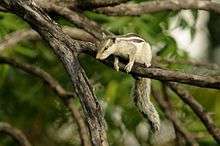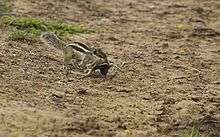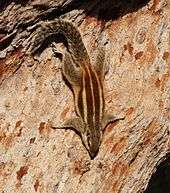Northern palm squirrel
| Northern palm squirrel | |
|---|---|
 | |
| Scientific classification | |
| Kingdom: | Animalia |
| Phylum: | Chordata |
| Class: | Mammalia |
| Order: | Rodentia |
| Family: | Sciuridae |
| Genus: | Funambulus |
| Subgenus: | Prasadsciurus Moore & Tate, 1965[2] |
| Species: | F. pennantii |
| Binomial name | |
| Funambulus pennantii Wroughton, 1905[3] | |
| Subspecies[4] | |
| |
The northern palm squirrel (Funambulus pennantii) also called the five-striped palm squirrel is a species of rodent in the family Sciuridae.[5] Some authorities recognise two subspecies, F. p. pennantii and F. p. argentescens. It is a semi-arboreal species found in tropical and subtropical dry deciduous forest and many other rural and urban habitats. It is a common species with a wide range and the International Union for Conservation of Nature has rated its conservation status as being of "least concern".
Distribution

It is found in the Andaman Islands, Nicobar Islands (where it is introduced), India, Nepal, Bangladesh, Pakistan and Iran. In India, it is fairly common in urban areas, even in large cities such as Delhi and Kolkata. Two subspecies, Funambulus pennantii argentescens and Funambulus pennantii lutescens, were suggested by Wroughton in addition to the nominate race; however, more recent workers do not make this distinction.
Thorington and Hoffman in Wilson and Reeder (2005) listed only two subspecies: F. p. pennantii and F. p. argentescens.[4] However, Ghose et al. (2004) described two additional subspecies: F. p. chhattisgarhi (distribution: eastern part of Maharashtra, Madhya Pradesh, Orissa, West Bengal and Bihar) and F. p. gangutrianus (distribution: West Bengal, Madhya Pradesh, Uttar Pradesh and Nepal),[6] but Talmale (2007) treated the Maharashtra populations as F. p. pennantii only due to the overlapping in measurements and colour variations observed in the specimens.[7][8][9] It has also been introduced to Irian Jaya, Papua New Guinea, New Britain, New Ireland, New Caledonia, Pohnpei, Fiji, Samoa, Tonga, Nauru, Vanuatu and Australia where it is found in Perth, Western Australia, establishing from zoo escapees.[10]
In India, the southern boundary of the species' range is not clearly identified, and recent records suggest it may extend as far as Madanapalli. The southern boundary on the Western Ghats side clearly extends to localities including Dharwar and Mysore, in Karnataka.[11][12]
Habitat

The northern palm squirrel is a very adaptable species. It occurs in tropical and subtropical dry deciduous forest, montane forests to altitudes of 4,000 m (13,123 ft), scrublands, plantations, grasslands, arable land, rural gardens and urban areas.[1]
Status
The northern palm squirrel is a common species throughout most of its wide range. It is an adaptable species and no particular threats have been identified, and the International Union for Conservation of Nature has rated its conservation status as being of "least concern".[1]
References
| Wikimedia Commons has media related to Funambulus pennantii. |
| Wikispecies has information related to: Funambulus pennantii |
- 1 2 3 Nameer, P. O. & S. Molur. (2008). Funambulus pennantii. In: IUCN 2012. IUCN Red List of Threatened Species. Version 2012.2. Downloaded on 03 June 2013.
- ↑ Moore, J.C. and G.H.H. Tate (1965). "A study of the diurnal squirrels, Sciurinae, of the Indian and Indo-Chinese subregions". Fieldiana Zoology. 48: 1–351.
- ↑ Wroughton, R.C. (1905). "The common striped palm squirrel". Journal of the Bombay Natural History Society. 16: 406–413.
- 1 2 Thorington, R.W., Jr.; Hoffmann, R.S. (2005). "Family Sciuridae". In Wilson, D.E.; Reeder, D.M. Mammal Species of the World: a taxonomic and geographic reference (3rd ed.). The Johns Hopkins University Press. pp. 754–818. ISBN 0-8018-8221-4. OCLC 26158608.
- ↑ Thorington, R. W. Jr. and R. S. Hoffman (2005). Family Sciuridae. Pp. 754-818 in Mammal Species of the World a Taxonomic and Geographic Reference. D. E. Wilson and D. M. Reeder eds. Johns Hopkins University Press, Baltimore.
- ↑ Ghose, R. K., Mandal, A. K. and Ghose, P. S. (2004). A contribution to the taxonomy of Indian five striped squirrel Funambulus pennanti, Wroughton), with description of two new subspecies. Rec. zool. Surv. India, 102 (3–4): 89–103
- ↑ Talmale, S.S. (2007). Studies on Small Mammal Diversity in Maharashtra State. PhD. Thesis submitted to University of Pune, Maharashtra State, India.
- ↑ Ellerman, J.R. (1961). The fauna of India including Pakistan, Burma and Ceylon: Mammalia, Rodentia. Volume 3 (in 2 parts). Vol. 1: 1-482 & Vol. 2: 483-884. Second ed. Zoological Survey of India, Calcutta.
- ↑ Srinivasulu C., S. Chakraborty and M.S. Pradhan (2004). "Checklist of the Sciurids (Mammalia: Rodentia: Sciuridae)" (PDF). Zoos' Print Journal. 19 (2): 1351–1360. doi:10.11609/jott.zpj.19.2.1351-60.
- ↑ Long, J. L. (2003). Introduced Mammals of the World: Their History, Distribution and Influence. Csiro Publishing, Collingwood, Australia. ISBN 9780643099166
- ↑ Pradhan, M.S. and Kurup, G.U. (2001). Mammalia IN Fauna of Nilgiri Biosphere Reserve. Fauna of conservation Area Series 11. Publ: Director, Zoological Survey of India, Kolkata: 311-330.
- ↑ Santharam, V. (2007). "Five-striped Palm Squirrel (Funambulus pennantii) in Rishi Valley, Chittoor district, Andhra Pradesh". J. Bombay Nat. Hist. Soc. 104 (2): 202.


